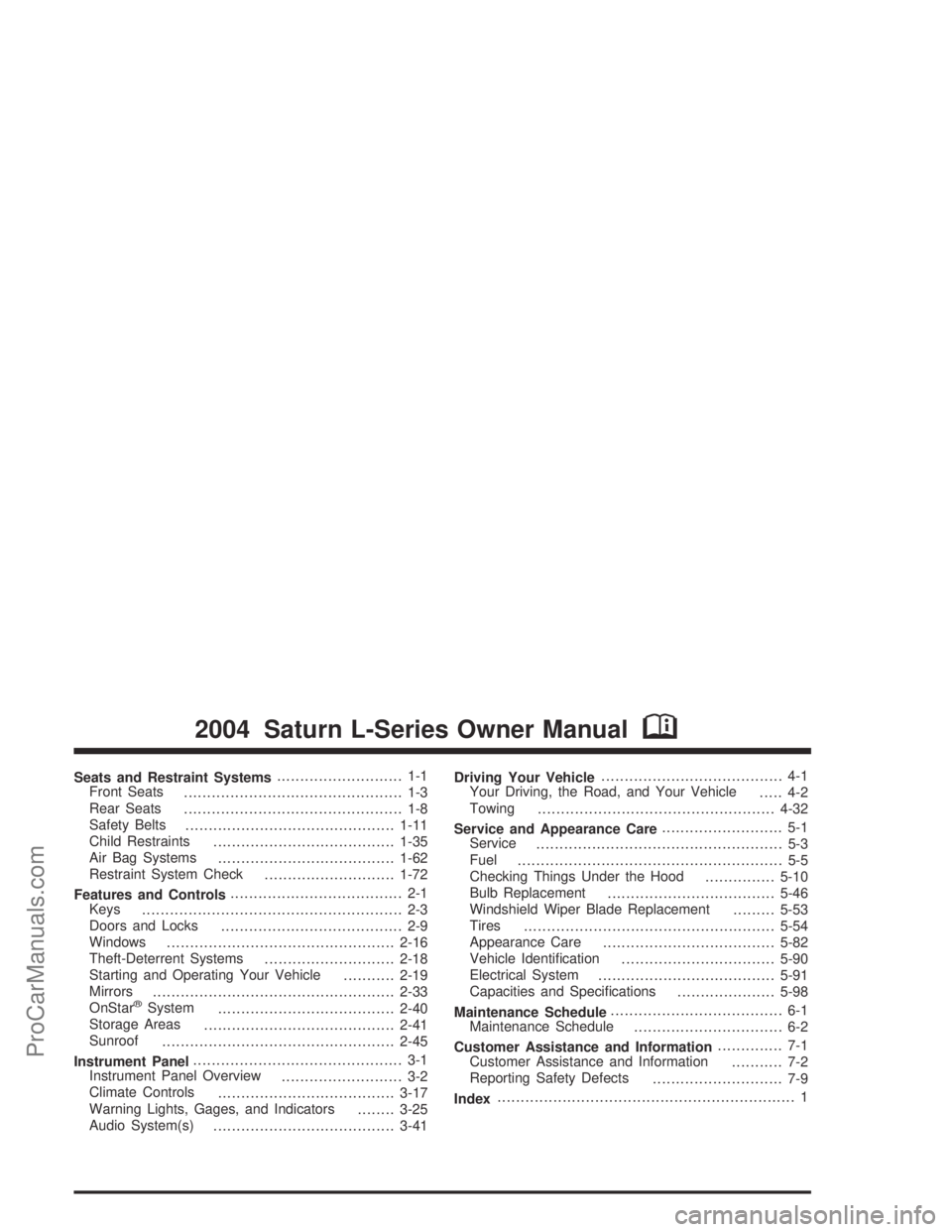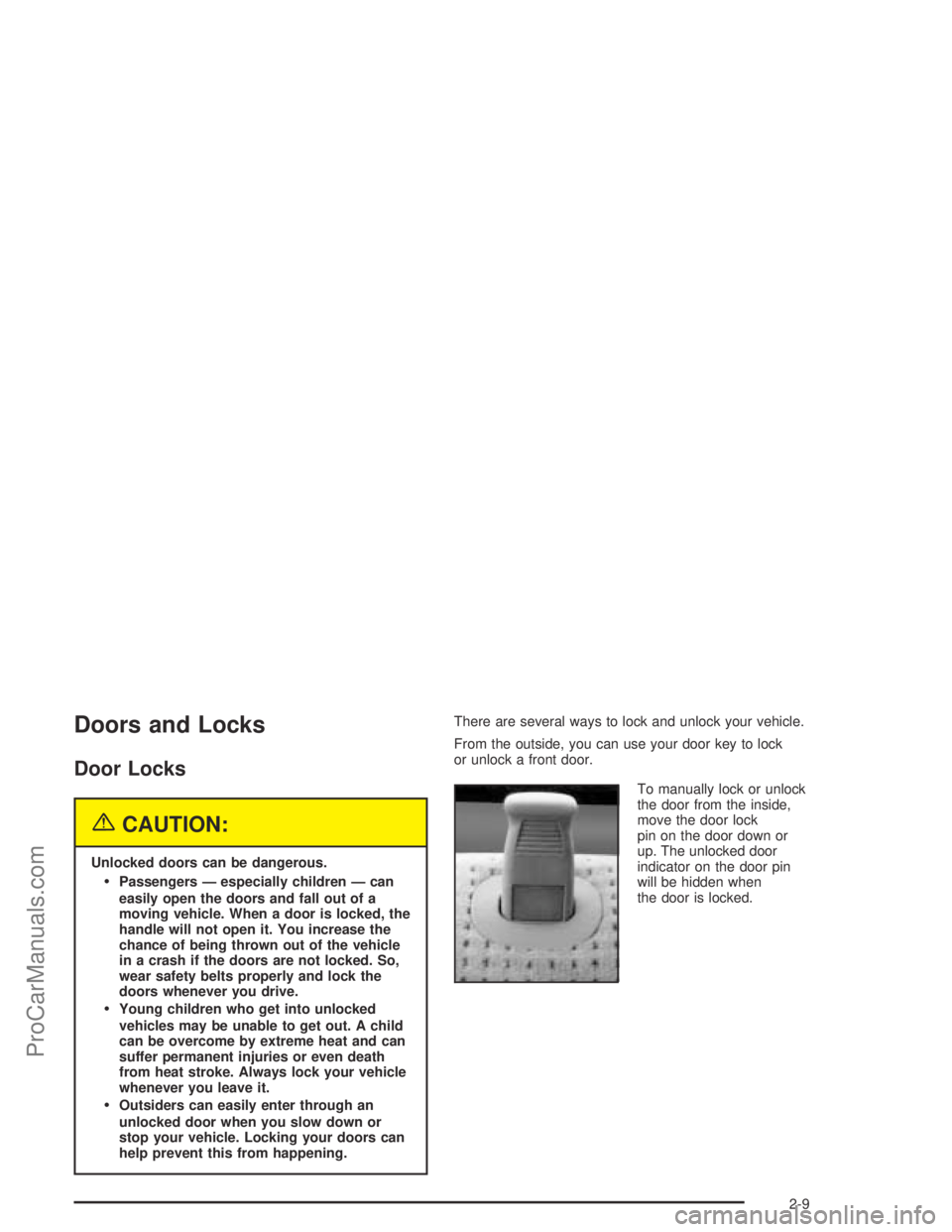child lock SATURN L-SERIES 2004 Owners Manual
[x] Cancel search | Manufacturer: SATURN, Model Year: 2004, Model line: L-SERIES, Model: SATURN L-SERIES 2004Pages: 386, PDF Size: 2.89 MB
Page 1 of 386

Seats and Restraint Systems........................... 1-1
Front Seats
............................................... 1-3
Rear Seats
............................................... 1-8
Safety Belts
.............................................1-11
Child Restraints
.......................................1-35
Air Bag Systems
......................................1-62
Restraint System Check
............................1-72
Features and Controls..................................... 2-1
Keys
........................................................ 2-3
Doors and Locks
....................................... 2-9
Windows
.................................................2-16
Theft-Deterrent Systems
............................2-18
Starting and Operating Your Vehicle
...........2-19
Mirrors
....................................................2-33
OnStar
®System
......................................2-40
Storage Areas
.........................................2-41
Sunroof
..................................................2-45
Instrument Panel............................................. 3-1
Instrument Panel Overview
.......................... 3-2
Climate Controls
......................................3-17
Warning Lights, Gages, and Indicators
........3-25
Audio System(s)
.......................................3-41Driving Your Vehicle....................................... 4-1
Your Driving, the Road, and Your Vehicle
..... 4-2
Towing
...................................................4-32
Service and Appearance Care.......................... 5-1
Service
..................................................... 5-3
Fuel
......................................................... 5-5
Checking Things Under the Hood
...............5-10
Bulb Replacement
....................................5-46
Windshield Wiper Blade Replacement
.........5-53
Tires
......................................................5-54
Appearance Care
.....................................5-82
Vehicle Identi�cation
.................................5-90
Electrical System
......................................5-91
Capacities and Speci�cations
.....................5-98
Maintenance Schedule..................................... 6-1
Maintenance Schedule
................................ 6-2
Customer Assistance and Information.............. 7-1
Customer Assistance and Information
........... 7-2
Reporting Safety Defects
............................ 7-9
Index................................................................ 1
2004 Saturn L-Series Owner ManualM
ProCarManuals.com
Page 31 of 386

The best way to protect the fetus is to protect the
mother. When a safety belt is worn properly, it’s more
likely that the fetus won’t be hurt in a crash. For
pregnant women, as for anyone, the key to making
safety belts effective is wearing them properly.
Right Front Passenger Position
To learn how to wear the right front passenger’s safety
belt properly, seeDriver Position on page 1-16.
The right front passenger’s safety belt works the same
way as the driver’s safety belt – except for one thing.
If you ever pull the shoulder portion of the belt out all the
way, you will engage the child restraint locking feature.
If this happens, just let the belt go back all the way
and start again.
Rear Seat Passengers
It is very important for rear seat passengers to buckle
up! Accident statistics show that unbelted people in
the rear seat are hurt more often in crashes than those
who are wearing safety belts.
Rear passengers who are not safety belted can be
thrown out of the vehicle in a crash. And they can strike
others in the vehicle who are wearing safety belts.
Rear Seat Passenger Positions (Sedan)
1-25
ProCarManuals.com
Page 89 of 386

Doors and Locks
Door Locks
{CAUTION:
Unlocked doors can be dangerous.
Passengers — especially children — can
easily open the doors and fall out of a
moving vehicle. When a door is locked, the
handle will not open it. You increase the
chance of being thrown out of the vehicle
in a crash if the doors are not locked. So,
wear safety belts properly and lock the
doors whenever you drive.
Young children who get into unlocked
vehicles may be unable to get out. A child
can be overcome by extreme heat and can
suffer permanent injuries or even death
from heat stroke. Always lock your vehicle
whenever you leave it.
Outsiders can easily enter through an
unlocked door when you slow down or
stop your vehicle. Locking your doors can
help prevent this from happening.There are several ways to lock and unlock your vehicle.
From the outside, you can use your door key to lock
or unlock a front door.
To manually lock or unlock
the door from the inside,
move the door lock
pin on the door down or
up. The unlocked door
indicator on the door pin
will be hidden when
the door is locked.
2-9
ProCarManuals.com
Page 211 of 386

Suppose you are steering through a sharp curve.
Then you suddenly apply the brakes. Both control
systems — steering and braking — have to do their work
where the tires meet the road. Unless you have
four-wheel anti-lock brakes, adding the hard braking can
demand too much of those places. You can lose
control.
The same thing can happen if you are steering through
a sharp curve and you suddenly accelerate. Those
two control systems — steering and acceleration — can
overwhelm those places where the tires meet the
road and make you lose control. SeeTraction Control
System (TCS) on page 4-9.
What should you do if this ever happens? Ease up on
the brake or accelerator pedal, steer the vehicle the way
you want it to go, and slow down.
Speed limit signs near curves warn that you should
adjust your speed. Of course, the posted speeds
are based on good weather and road conditions. Under
less favorable conditions you will want to go slower.
If you need to reduce your speed as you approach
a curve, do it before you enter the curve, while your front
wheels are straight ahead.
Try to adjust your speed so you can “drive” through the
curve. Maintain a reasonable, steady speed. Wait to
accelerate until you are out of the curve, and then
accelerate gently into the straightaway.Steering in Emergencies
There are times when steering can be more effective
than braking. For example, you come over a hill and �nd
a truck stopped in your lane, or a car suddenly pulls
out from nowhere, or a child darts out from between
parked cars and stops right in front of you. You
can avoid these problems by braking — if you can stop
in time. But sometimes you can not; there is not
room. That is the time for evasive action — steering
around the problem.
Your vehicle can perform very well in emergencies like
these. First apply your brakes — but, unless you
have anti-lock, not enough to lock your wheels.
SeeBraking on page 4-6. It is better to remove as much
speed as you can from a possible collision. Then
steer around the problem, to the left or right depending
on the space available.
4-11
ProCarManuals.com
Page 254 of 386

Filling Your Tank
{CAUTION:
Fuel vapor burns violently and a fuel �re can
cause bad injuries. To help avoid injuries to
you and others, read and follow all the
instructions on the pump island. Turn off your
engine when you are refueling. Do not smoke
if you are near fuel or refueling your vehicle.
Keep sparks, �ames and smoking materials
away from fuel. Do not leave the fuel pump
unattended when refueling your vehicle — this
is against the law in some places. Keep
children away from the fuel pump; never let
children pump fuel.The fuel �ller cap is
located behind a hinged
door on the passenger’s
side of your vehicle. It
is tethered to the door to
prevent loss while
refueling. Make sure that
water, snow, and dirt
are kept away from the
�ller cap and �ller
pipe nozzle.
To remove the fuel cap, turn it slowly to the left
(counterclockwise). It will require about 1/2 of a turn to
remove the cap. The fuel cap has a spring in it; if
you let go of the cap too soon, it will spring back to the
right (clockwise).
{CAUTION:
If you get fuel on yourself and then something
ignites it, you could be badly burned. Fuel can
spray out on you if you open the fuel cap too
quickly.
CAUTION: (Continued)
5-8
ProCarManuals.com
Page 379 of 386

I
If No Steam Is Coming From Your Engine..........5-28
If Steam Is Coming From Your Engine...............5-27
If the Light Is Flashing.....................................3-35
If the Light Is On Steady.................................3-35
If You Are Caught in a Blizzard.........................4-28
If You Are Stuck in Sand, Mud, Ice or Snow.......4-30
If You Do Decide to Pull a Trailer......................4-41
Ignition Positions.............................................2-20
Infants and Young Children, Restraints...............1-38
In�ation - Tire Pressure...................................5-61
Installing the Cargo Shade...............................2-44
Instrument Panel
Cluster.......................................................3-26
Overview..................................................... 3-2
Instrument Panel Brightness.............................3-15
Interior Lamps................................................3-15
J
Jump Starting.................................................5-40
K
Keyless Entry System....................................... 2-4
Keys............................................................... 2-3
L
Lamps
Exterior......................................................3-13
Fog Lamps.................................................5-49
Interior.......................................................3-15
Lap Belt........................................................1-32
Lap-Shoulder Belt...........................1-17, 1-26, 1-29
LATCH System
Child Restraints...........................................1-50
Securing a Child Restraint Designed for the
LATCH System........................................1-52
Leaving Your Vehicle.......................................2-12
Leaving Your Vehicle With the
Engine Running..........................................2-29
Liftgate Release (Wagon).................................2-14
Liftgate/Trunk.................................................2-13
Light
Air Bag Readiness.......................................3-28
Anti-Lock Brake System Warning...................3-31
Battery Warning..........................................3-29
Brake System Warning.................................3-30
Change Engine Oil......................................3-38
Daytime Running Lamps Indicator..................3-39
Engine Coolant Temperature Warning.............3-32
Low Coolant Warning...................................3-33
Low Fuel Warning.......................................3-40
Low Washer Fluid Warning...........................3-39
7
ProCarManuals.com
Page 381 of 386

Mirrors
Automatic Dimming Rearview with Compass
and Temperature Display...........................2-36
Automatic Dimming Rearview with OnStar
®,
Compass and Temperature Display.............2-34
Manual Rearview Mirror................................2-33
Manual Rearview Mirror with OnStar
®.............2-33
Outside Convex Mirror.................................2-39
Outside Heated Mirrors................................2-39
Outside Power Mirrors..................................2-39
Outside Remote Control Mirror......................2-38
MyGMLink.com................................................ 7-4
N
New Vehicle Break-In......................................2-19
Normal Maintenance Replacement Parts............6-13
O
Odometer......................................................3-27
Off-Road Recovery..........................................4-12
Oil
Change Engine Oil Light...............................3-38
Engine.......................................................5-16
Pressure Light.............................................3-37
Older Children, Restraints................................1-35
Online Owner Center........................................ 7-4
OnStar
®Personal Calling.................................2-41OnStar
®Services............................................2-40
OnStar®System.............................................2-40
OnStar®Virtual Advisor....................................2-41
Operation......................................................3-18
Other Warning Devices...................................... 3-5
Outlet Adjustment............................................3-24
Outside
Convex Mirror.............................................2-39
Heated Mirrors............................................2-39
Power Mirrors.............................................2-39
Remote Control Mirror..................................2-38
Owner Checks and Services.............................. 6-9
Owner Publications.........................................7-11
Owners, Canadian............................................... ii
P
Park (P)
Shifting Into................................................2-28
Shifting Out of............................................2-30
Parking
Brake........................................................2-27
Over Things That Burn.................................2-30
Parking on Hills..............................................4-45
Passenger Compartment Air Filter.....................3-24
Passing.................................................4-13, 4-44
Passlock
®......................................................2-18
Playing a Cassette Tape..................................3-52
Playing a CD.................................................3-47
9
ProCarManuals.com